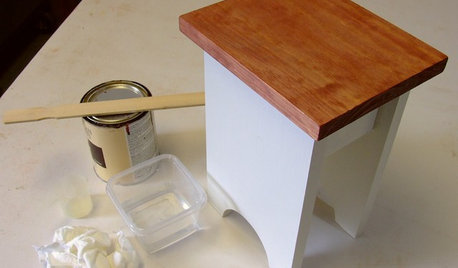specks of latex paint on mahogany furniture
melinda_belinda
11 years ago
Related Stories

DIY PROJECTSUpcycle Furniture Finds With Paint
There are products out there designed to help you transform your thrift-store scores
Full Story
PAINTINGWhat to Know About Milk Paint and Chalk Paint — and How to Use Them
Learn the pros, cons, cost and more for these two easy-to-use paints that are great for giving furniture a vintage look
Full Story
BUDGET DECORATINGBudget Decorator: 8 Ways to Make Old Furniture Look Brand New
Learn stripping, staining, painting and reupholstering basics to make bargain-basement furniture worthy of center stage at home
Full Story
COLOR12 Tried-and-True Paint Colors for Your Walls
Discover one pro designer's time-tested favorite paint colors for kitchens, baths, bedrooms and more
Full Story
DECORATING GUIDES10 Reasons to Embrace White Walls
Do they strike you as even more boring than watching white paint dry? Consider what makes them the darling of so many
Full Story
REMODELING GUIDESAre You Gutsy Enough to Paint Your Floor White?
Sleek and glossy or softened by wear, white floors charm
Full Story
DIY PROJECTSCool Tip: Mimic Stain With a DIY Color Wash
Get the look of an oil-based stain without all the bother, using this easy wash made with paint
Full Story
TRIMWhat Color Should You Paint Your Trim?
Learn the benefits of painting your trim white, black, neutral, a bold color and more
Full Story
MOST POPULARFrom the Pros: How to Paint Kitchen Cabinets
Want a major new look for your kitchen or bathroom cabinets on a DIY budget? Don't pick up a paintbrush until you read this
Full Story
MOST POPULARSo You Say: 30 Design Mistakes You Should Never Make
Drop the paint can, step away from the brick and read this remodeling advice from people who’ve been there
Full StoryMore Discussions











randy427
brickeyee
Related Professionals
National City Cabinets & Cabinetry · Spring Valley Cabinets & Cabinetry · Cedar Park Carpenters · North Lauderdale Carpenters · Corona Flooring Contractors · Kalispell Flooring Contractors · Mahwah Flooring Contractors · Surprise Flooring Contractors · West Linn Flooring Contractors · Fullerton Flooring Contractors · Dallas Furniture & Accessories · Reston Furniture & Accessories · Savannah Furniture & Accessories · Discovery Bay Furniture & Accessories · Miami Beach Furniture & Accessoriesrwiegand
brickeyee
sloyder
rwiegand
brickeyee
rwiegand